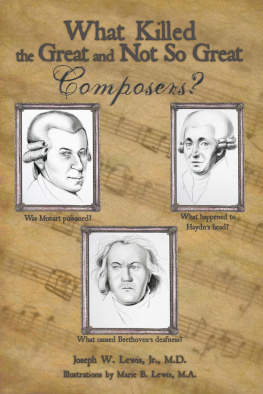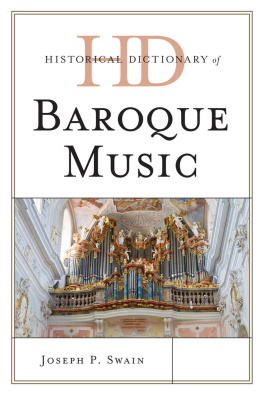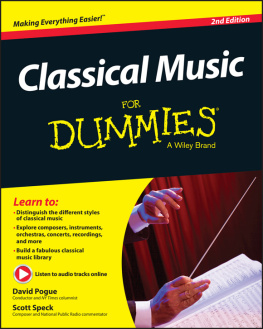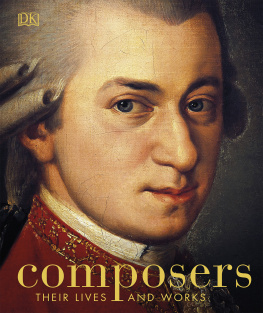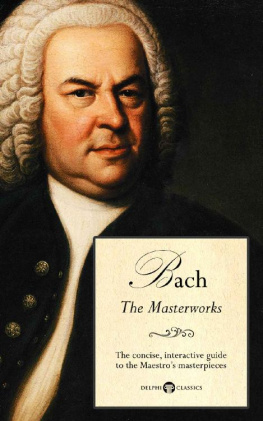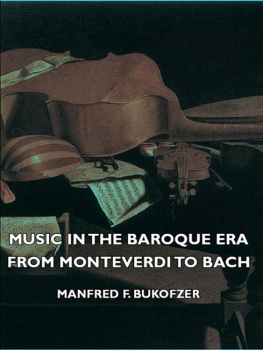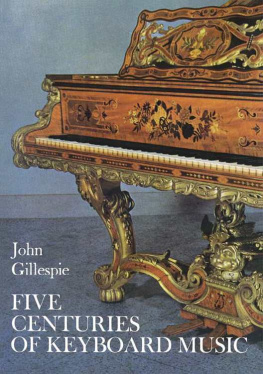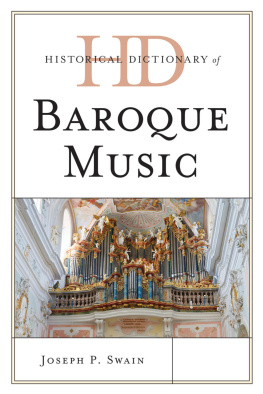What Killed the Great and Not So Great Composers?
Joseph W. Lewis, Jr., M.D.
Illustrations by Marie B. Lewis, M.A.

AuthorHouse
1663 Liberty Drive
Bloomington, IN 47403
www.authorhouse.com
Phone: 1-800-839-8640
2010 Joseph W. Lewis, Jr., M.D.. All rights reserved.
No part of this book may be reproduced, stored in a retrieval system, or transmitted by any means without the written permission of the author.
First published by AuthorHouse 5/14/2010
ISBN: 978-1-4490-7584-2 (sc)
Printed in the United States of America
Bloomington, Indiana
This book is printed on acid-free paper.
For Dorothy and Harry
Contents
Illustrations
Chapter 2. George Frideric Handel
Chapter 3. Johann Sebastian Bach
Chapter 4. Joseph Haydn
Chapter 5. Wolfgang Amadeus Mozart; Mozart ear
Chapter 6. Ludwig van Beethoven
Chapter 7. Niccol Paganini; Paganinis left hand finger span
Chapter 8. Carl Maria von Weber
Chapter 9. Gioachino Rossini
Chapter 10. Franz Schubert
Chapter 11. Hector Berlioz
Chapter 12. Felix Mendelssohn Bartholdy; Berry aneurysm
Chapter 13. Fryderyk Chopin
Chapter 14. Robert Schumann
Chapter 15. Franz Liszt
Chapter 16. Richard Wagner
Chapter 17. Johannes Brahms
Chapter 18. Georges Bizet
Chapter 19. Modest Mussorgsky
Chapter 20. Pyotr Tchaikovsky
Chapter 21. Gustav Mahler
Chapter 22. Sergei Rachmaninoff
Chapter 23. Maurice Ravel
Chapter 24. Igor Stravinsky
Chapter 25. George Gershwin
Chapter 26. Dmitri Shostakovich
Chapter 27. Benjamin Britten
Acknowledgements
During the years spent researching and assembling material for this book, I have received help and encouragement from many people in the musical and medical communities. I would like to thank Marian Horowitz for her excellent editorial counseling and Christopher S. Coffey, PhD for his invaluable statistical help. I also wish to thank Sidney Beck, M.D., Jeffrey Chace, Les Fillmer, Joseph Forbes, Nicole Groux, P.A.C., MPAS, Myron Kopin, M.D., Gale Kramer, Ph.D., Amelia Lewis, Joseph W. Lewis, III, Fadi Matta, M.D., Robert Bruce McClelland, Lawrence Mitchell, M.D., Jennifer Richardson, William Sanders, M.D., Michael Simoff, M.D., Paul Stein, M.D., Marilynn Sultana-Gallick M.D. and Charles Wood who helped bring this book to fruition. A special vote of thanks goes to Ralph Stillwell and Marie Lewis, without whose support this endeavor would not have been completed.
Introduction
What killed Mozart? What caused Beethovens deafness? Did Schubert die of advanced syphilis? Was Gershwins brain tumor malignant? These and similar questions have been raised about various illnesses suffered by some of the great classical musicians, but surprisingly, many remain unanswered. Why should this be such a continuing problem?
Recollections of past events, unless carefully documented and verified, often have a tendency to blur, fade and even disappear with time. To put together the medical histories of composers who lived hundreds of years ago, one must contend with missing or destroyed factual material, statements no longer verifiable and the general ignorance of medical matters prevalent in earlier times. Retrospectively constructing a medical history is akin to piecing together a complicated jigsaw puzzle. If all pieces are present, a bit of skill and patience eventually allows assembly of individual parts into a recognizable picture of a composers ailments. However, lost or distorted factual material and the difficulty of sorting out historical details can lead to a skewed or erroneous view of a subjects medical story. When sifting through the maze of available historical material, the old admonition caveat emptor should be invoked but modified to convey a slightly different warning: let the reader (and writer) beware of unsubstantiated facts.
While primitive recordings of medical matters can be traced back to cave graffiti from the Upper Paleolithic Period (between 40,000 to 10,000 years ago), systematic patient-oriented medical records were not widely accepted or used until the 20th century. Many illnesses experienced before this time were treated at home, where little or no permanent documentation of methods or outcomes survived. Most information about ailments of composers who lived centuries ago has been pieced together from available letters, memoirs, diaries or other pertinent documents. Prior to the advancement of medical technology in the mid-to-late 19th century, physicians relied primarily on their physical diagnostic ability, a skill frequently limited by inconsistency and error. Autopsies performed in earlier times often were restricted by the expertise of individual prosectors and the technological advancements available to them. Some of these post mortem examinations, because of these shortcomings, generated as much controversy as enlightenment.
Fortunately, a good number of musicians carried on a lively correspondence with relatives and acquaintances, penning in detail their indispositions and injuries. Occasionally, descriptions of illnesses were recorded decades after the fact, raising the possibility that time distorted some of the memories. In a number of instances, details appear to have been significantly altered to either enhance or detract from the perception of a composers stature or to exaggerate the writers association with that person. During the last decade of Ludwig van Beethovens life, questions and comments from friends and colleagues were written in conversation books to facilitate communication with the deaf composer (see Chapter 6). After Beethovens death, his biographer and sometime valet Anton Schindler destroyed a number of these volumes (some say as many as half) and altered others so that a somewhat idealized portrait of his employer might be perceived from the extant copies. Barry Cooper in his Beethoven Compendium writes that ... [Schindlers] propensity for inaccuracy and fabrication was so great that virtually nothing he has recorded can be relied on unless it is supported by other evidence...
To cloud the picture further, descriptions of potential factors responsible for Beethovens terminal illness seemed to vary from individual to individual. The composer died of liver failure complicating cirrhosis, a disease often associated with alcohol abuse. Although many factors contribute to liver injury, the degree of alcohol consumption, if pertinent, also becomes a major issue in the progression of the disease. Karl Holz, one of the composers friends, commented: ... he drank a great deal of wine at table, but could stand a great deal, and in merry company he sometimes became tipsy. In an 1827 conversation book entry, Schindler countered: [Holz] said that you always drink more than a quart of wine at lunch, and other untruths. Dr. Andreas Wawruch (1773-1842), who attended the composer in his last days, stated: ... At no time accustomed to taking medical advice seriously, [Beethoven] began to develop a liking for spirituous beverages, in order to stimulate his decreasing loss of appetite and to aid his stomachic weakness by excessive use of strong punch and iced drinks... The valet apparently removed some of the unflattering entries made by Wawruch during the final stages of the composers illness. Schindler influenced Franz Wegeler, Beethovens boyhood friend from Bonn, to write: By and large Beethoven lived very moderately, and as far as I know, not one of his friends and acquaintances ever saw him intoxicated. Was Beethoven an alcoholic whose destructive habit resulted in cirrhosis, or did he drink in moderation, dying from an otherwise indiscernible injury to the liver? The answer probably never will be known with any certainty. The truth undoubtedly lies somewhere between these two extremes. Similarly disputed or altered details littering other composers medical histories must raise flags of caution when they are used to bolster pet hypotheses about causes of illness and death.
Next page
